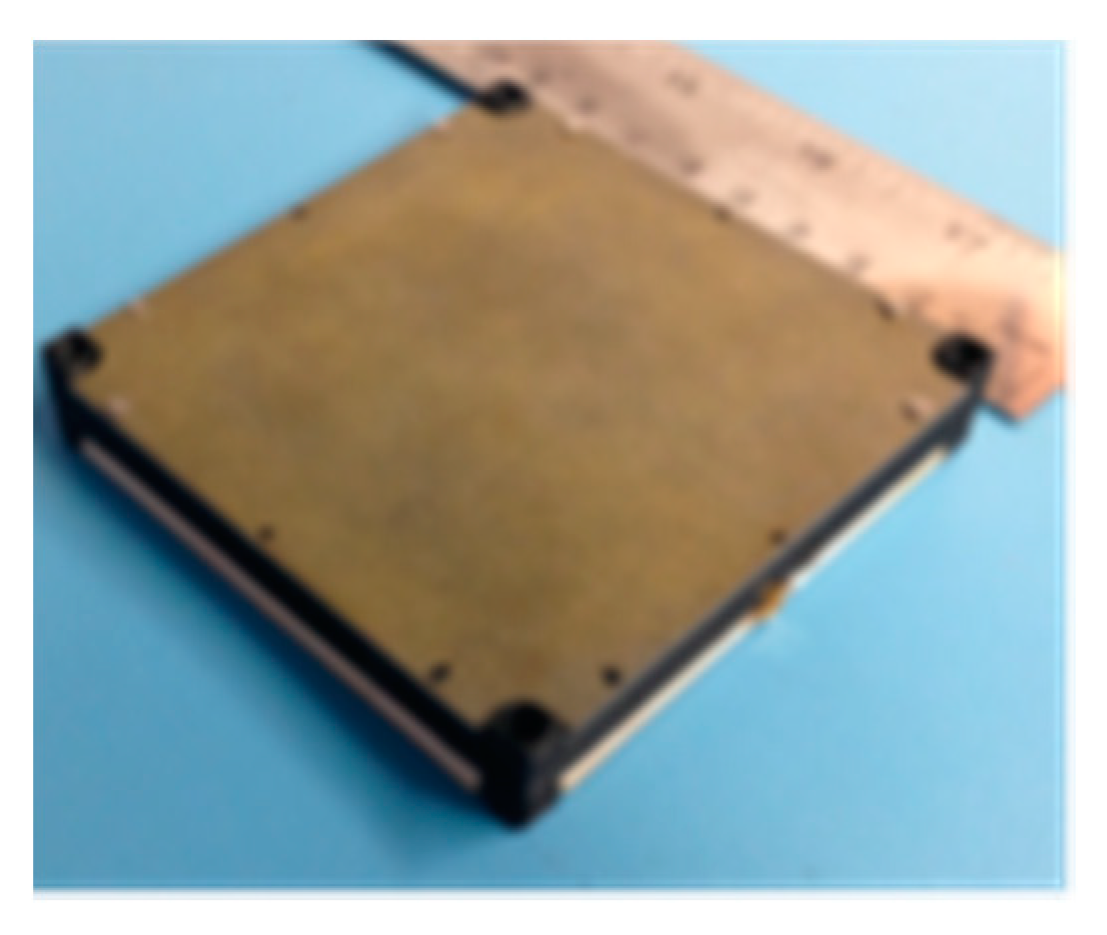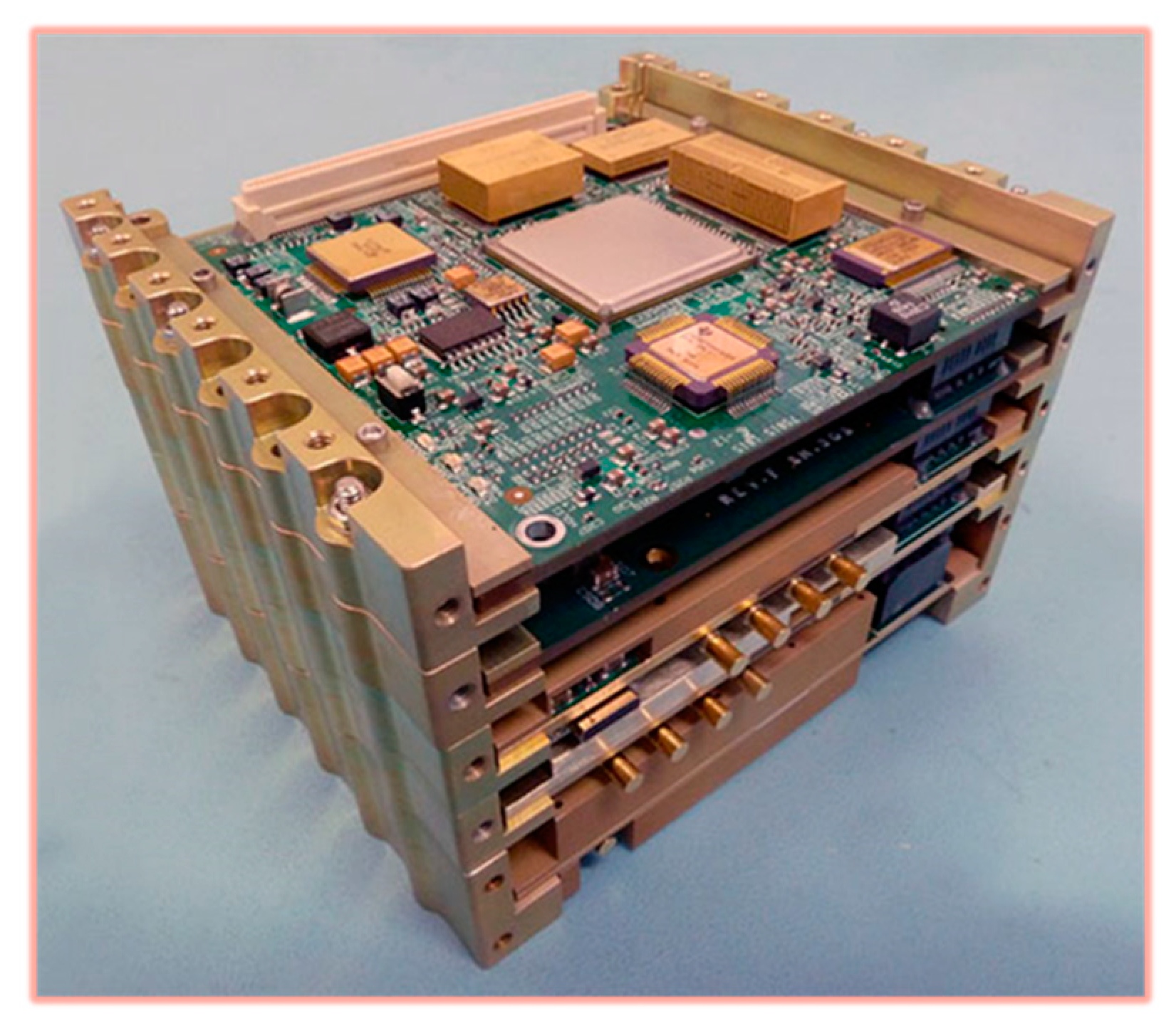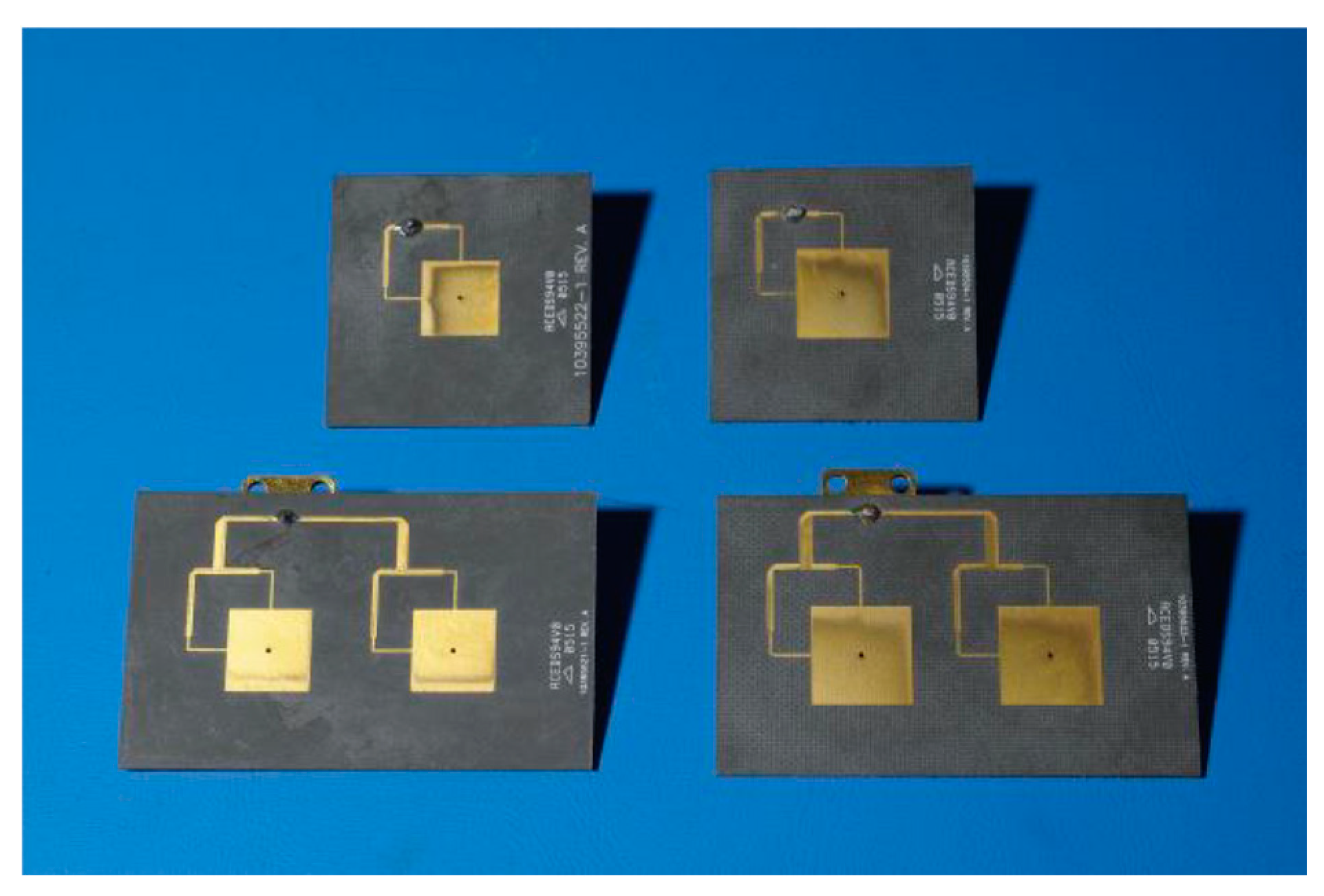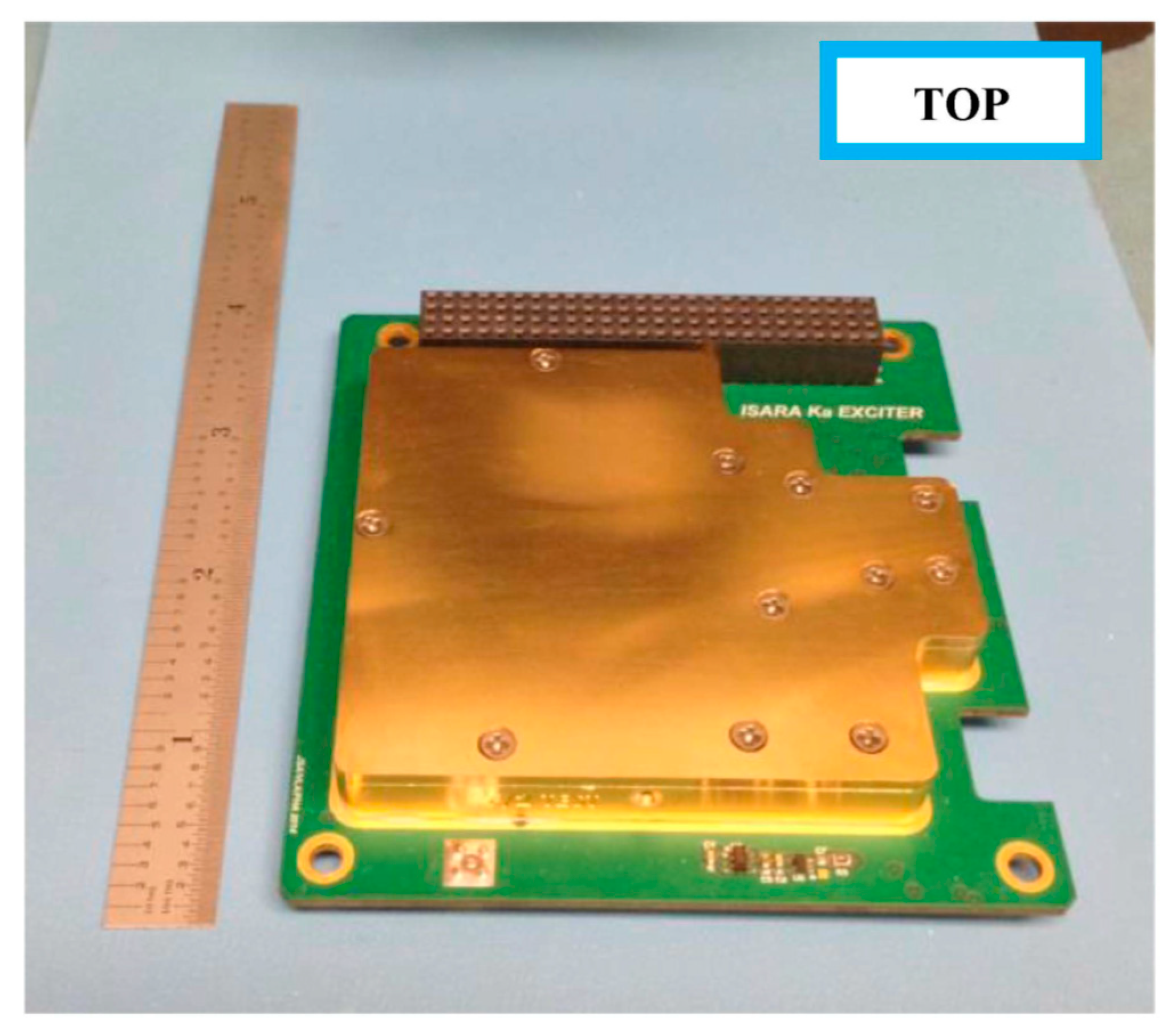Telecommunication Systems for Small Satellites Operating at High Frequencies: A Review
Abstract
:1. Introduction
2. ASTERIA
2.1. Telecommunication Requirements and Design
2.2. Hardware Characteristics
2.3. Operations
- ASTERIA was relying on only one ground station.
- The MSU station has a very small beamwidth, as a result of having such a large dish (21 m).
- The ASTERIA antennas are regulated by a switch, so there is no omnidirectional coverage of the spacecraft.
- The radio does not support a beacon mode, and it needs to receive an uplink signal before it can activate the downlink.
- The radio was on a duty cycle for which it was on for 30 min and off for 10 min, due to power consumption constraints.
- The spectrum was shifting in frequency faster than expected due to both Doppler and spacecraft rotation.
- Downlink Eb/N0 was lower than expected due to
- (a)
- The high level of uplink power was saturating the ASTERIA receiver.
- (b)
- The rotation of the spacecraft was affecting the antenna pointing.
- (c)
- Though not known at the beginning of the operations, the LNA at the ground station was failing. This failure was discovered during the extended mission phase. Replacing the LNA resulted in a 3 dB increase in the received Eb/N0).
- The downlink receiver bandwidth was increased by a factor of 10 to reduce the loss of lock.
- The uplink signal from the ground station was reduced by approximately 9 dB in order to avoid receiver saturation.
- The spacecraft pointing system was commanded to point the antenna at the ground station to limit the loss of contact due to spacecraft rotation.
3. MarCO
3.1. Telecommunication Requirements and Design
3.2. Hardware Characteristics
3.3. Operations
- The gain of the HGA reflectarray antennas were characterized on both spacecraft by pointing the antenna to different attitudes and measuring the received power on the ground
- The bent-pipe EDL mode was tested using the UHF Stanford ground station that simulated the InSight spacecraft and sent signals to both MarCo spacecraft. Both MarCO spacecraft successfully retransmitted the signal to the Deep Space Network
- Both MarCo spacecraft were also received by the Morehead State University ground station, the same as ASTERIA that for the occasion was upgraded with X-Band receiving capabilities.
4. ISARA
4.1. Telecommunication Requirements and Design
4.2. Hardware Characteristics
4.3. Operations
5. Comparison
- The systems are not fully redundant but they have some redundancy in terms of antennas or frequencies used. ASTERIA has a single radio but two antennas which can be used alternatively. MarCO has two receivers (UHF and X-Band), three X-Band transmitting antennas (LGA, MGA, HGA), and three receiving antennas (one at UHF, and two at X-Band). ISARA has an uplink/downlink system at UHF and a Ka-Band downlink.
- Each component was carefully tested at the vendor and at JPL (at the system level for the spacecraft integrated at JPL: MarCO and ASTERIA).
6. Conclusions
Funding
Acknowledgments
Conflicts of Interest
References
- Babuscia, A.; di Pasquale, P.; Smith, M.W.; Taylor, J. Arcsecond Space Telescope Enabling Research in Astrophysics (ASTERIA) Telecommunications. In JPL Descanso Performance Summary Series 2019. Available online: https://descanso.jpl.nasa.gov/NEDSummary/NED-PSS_ASTERIA_FINAL.pdf (accessed on 8 May 2020).
- NASA. Mars Cubesat One (MarCO). Jet Propulsion Laboratory. Available online: https://www.jpl.nasa.gov/cubesat/missions/marco.php (accessed on 7 May 2020).
- NASA. Beyond Mars, the Mini MarCO Spacecraft Fall Silent. 5 February 2019. Available online: https://www.jpl.nasa.gov/news/news.php?feature=7327 (accessed on 7 May 2020).
- Shihabi, M.; Duncan, C.; Kobayashi, M.M.; Holmes, S. The Evolution of the Jet Propulsion Laboratory/NASA Iris Deep-Space Transponder. In Proceedings of the 8th TTC 2019, Darmstadt, Germany, 24–29 September 2019. [Google Scholar]
- Holmes, S.; Kobayashi, M.; Shihabi, M. Iris at Mars: First Flight Use of Iris Deep Space Transponder on MarCO. In Proceedings of the Inetrplanetary Small Satellite Conference, San Luis Obispo, CA, USA, 29–30 April 2019. [Google Scholar]
- Chahat, N.; Decrossas, E.; Gonzalez-Ovejero, D.; Yurduseven, O.; Radway, M.J.; Hodges, R.E.; Estabrook, P.; Baker, J.D.; Bell, D.J.; Cwik, T.A.; et al. Advanced CubeSat Antennas for Deep Space Science Mission: A Review. IEEE Antennas Propag. Mag. 2019, 61, 37–46. [Google Scholar] [CrossRef] [Green Version]
- Hodges, R.; Chahat, N.; Hoppe, D.; Vacchione, J. A Deployable High Gain Antenna Bound for Mars. IEEE Antennas Propa Gation Mag. 2017, 59, 39–49. [Google Scholar] [CrossRef]
- Decrossas, E.; Chahat, N.; Walkemeyer, P.E.; Velasco, S.B. Deployable Circularly Polarized UHF Printed Loop Antenna for Mars Cube One (MarCO) CubeSat. In Proceedings of the 2019 IEEE International Symposium on Antennas and Propagation and USNC-URSI Radio Science Meeting, Atlanta, GA, USA, 7–12 July 2019. [Google Scholar]
- NASA. Integrated Solar Array & Reflectarray Antenna (ISARA). Available online: https://www.jpl.nasa.gov/cubesat/missions/isara.php (accessed on 7 May 2020).
- NASA. 25 July 2018. Available online: https://www.nasa.gov/sites/default/files/atoms/files/factsheet_isara_25july2018-508.pdf (accessed on 7 May 2020).
- Aerospace. Available online: https://aerospace.org/article/mission-success-cumulos-and-isara-cubesat (accessed on 7 May 2020).
- Hodges, R.E.; Lewis, D.K.; Radway, M.J.; Toorian, A.S.; Aguirre, F.H.; Hoppe, D.J.; Shah, B.N.; Gray, A.A. The ISARA Mission–Flight Demonstration of a High Gain Ka-Band Antenna. In Proceedings of the 32nd Annual AIAA/USU Conference on Small Satellites, San Diego, CA, USA, 19–23 August 2018. [Google Scholar]
- Aguirre, F.; Custodero, B.; Shah, B. Ka-Band Tone Generator for the ISARA Cubesat. In Proceedings of the IEEE Aerospace Conference, Big Sky, MT, USA, 7–14 March 2015. [Google Scholar]
- Hodges, R.E.; Radway, M.J.; Toorian, A.; Hoppe, D.J.; Shah, B.; Kalman, A.E. ISARA—Integrated Solar Array and Reflectarray CubeSat Deployable Ka-band Antenna. In Proceedings of the 2015 IEEE International Symposium on Antennas and Propagation Joint CNC/USNC-URSI Meeting, Vancouver, BC, Canada, 19–25 July 2015. [Google Scholar]











| Parameter | ASTERIA Antenna |
|---|---|
| Frequency | 2.0–2.11 GHz (receive) 2.2–2.3 GHz (transmit) |
| Peak gain | 7 dBi |
| Half-power beamwidth | 70 deg |
| Power handling | 10 W |
| Impedance | 50 Ohm |
| Polarization | RHCP |
| Temperature Range | −40 deg C to +85 deg C |
| Parameter | X-Band HGA | X-Band MGA | X-Band LGA | UHF |
|---|---|---|---|---|
| Frequency | 7.14–7.23 GHz (receive) 8.4–8.5 GHz (transmit) | 7.14–7.23 GHz (receive) 8.4–8.5 GHz (transmit) | 7.14–7.23 GHz (receive) 8.4–8.5 GHz (transmit) | 401 MHz (receive) |
| Peak gain | 29.2 dBi | 9 dBi | 6 dBi | 2.5 dBi |
| Half-power beamwidth | 5.5 deg | 20 deg | 60 deg | 60 deg |
| Power handling | 10 W | 10 W | 10 W | 10 W |
| Impedance | 50 Ohm | 50 Ohm | 50 Ohm | 50 Ohm |
| Polarization | RHCP | RHCP | RHCP | RHCP |
| Temperature Range | −55 °C to +125 °C | −55 °C to +125 °C | −55 °C to +125 °C | −55 °C to +125 °C |
| Parameter | ISARA Antenna |
|---|---|
| Frequency | 26 GHz (transmit) |
| Peak gain | 33.5 dBi |
| Half-power beamwidth | 2.5 deg |
| Power handling | 10 W |
| Impedance | 50 Ohm |
| Polarization | RHCP |
| Temperature Range | −40 deg C to +85 deg C |
| ASTERIA | MarCO | ISARA | |
|---|---|---|---|
| Transmitting band | S | X | Ka and UHF |
| Receiving band | S | X and UHF | UHF |
| Ground station | Morehead State University (MSU) | Deep Space Network (DSN) | Aerospace Corporation Stations (UHF) Jet Propulsion Laboratory (Ka-band) |
| Downlink data rates | 10 kbps and 1 Mbps | Variable from 62.5 bps up to 8 kbps | N/A at Ka-Band (only tones) |
| Uplink data rates | 4 kbps and 32 kbps | 62.5 bps and 1 kbps | N/A (at Ka-band) |
| Transmit power | 1 W | 4 W | 0.5 W |
| Antenna gain | 7 dBi | 6 dBi (LGA) 9 dBi (MGA) 29.2 dBi (HGA) 2.5 dBi (UHF) | 18.9 (SGA) 33.5 dBi (HGA) |
| Modulation and encoding type downlink | OQPSK with Reed Solomon (255,223) | Subcarrier or direct carrier BPSK with Reed Solomon (255,223), convolutional (K = 7, r = 1/2), Turbo ½, Turbo 1/3 and Turbo 1/6 | N/A at Ka-Band |
| Modulation and encoding type uplink | BPSK (uncoded) | PCM/PSK/PM (uncoded) | N/A at Ka-Band |
| Receiver NF | 4 dB | 5 dB | N/A at Ka-Band |
| BER | 10−5 | 10−5 | N/A at Ka-Band (carrier only) |
© 2020 by the author. Licensee MDPI, Basel, Switzerland. This article is an open access article distributed under the terms and conditions of the Creative Commons Attribution (CC BY) license (http://creativecommons.org/licenses/by/4.0/).
Share and Cite
Babuscia, A. Telecommunication Systems for Small Satellites Operating at High Frequencies: A Review. Information 2020, 11, 258. https://doi.org/10.3390/info11050258
Babuscia A. Telecommunication Systems for Small Satellites Operating at High Frequencies: A Review. Information. 2020; 11(5):258. https://doi.org/10.3390/info11050258
Chicago/Turabian StyleBabuscia, Alessandra. 2020. "Telecommunication Systems for Small Satellites Operating at High Frequencies: A Review" Information 11, no. 5: 258. https://doi.org/10.3390/info11050258
APA StyleBabuscia, A. (2020). Telecommunication Systems for Small Satellites Operating at High Frequencies: A Review. Information, 11(5), 258. https://doi.org/10.3390/info11050258




